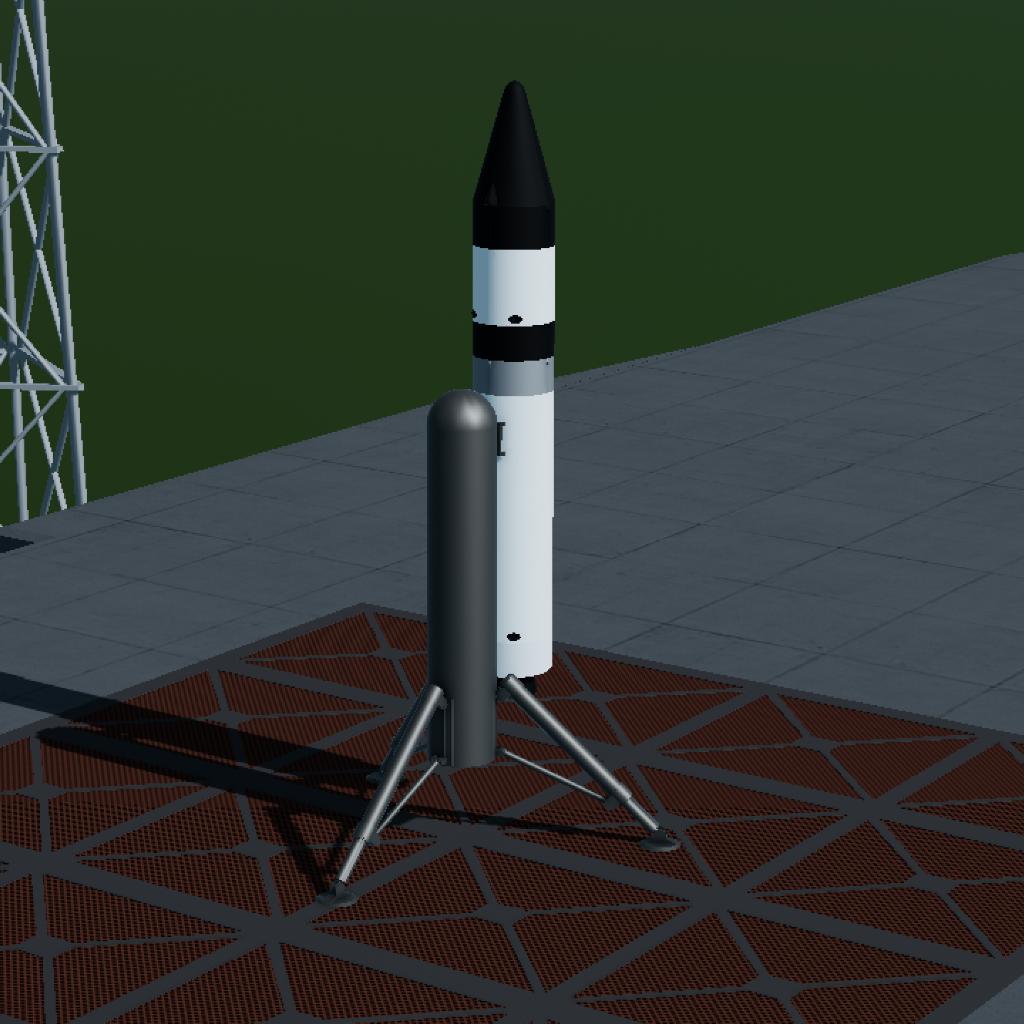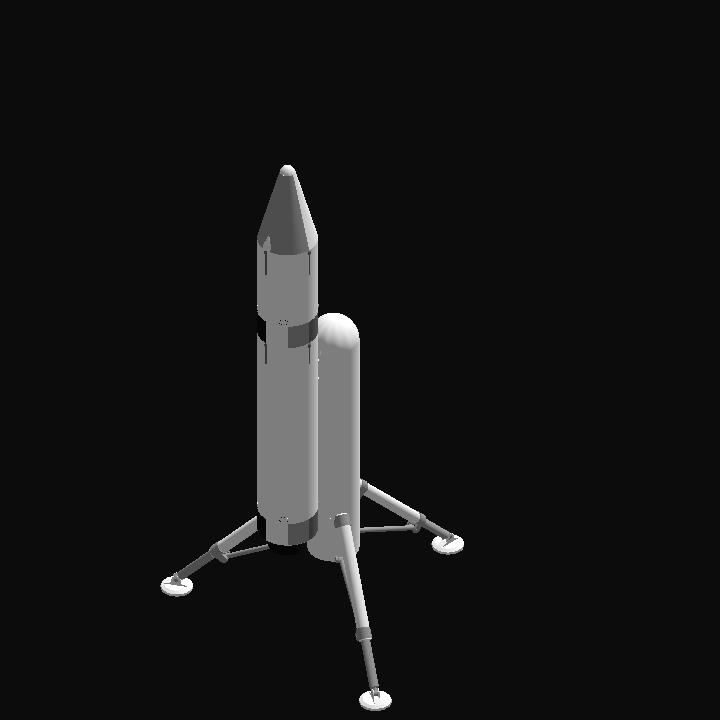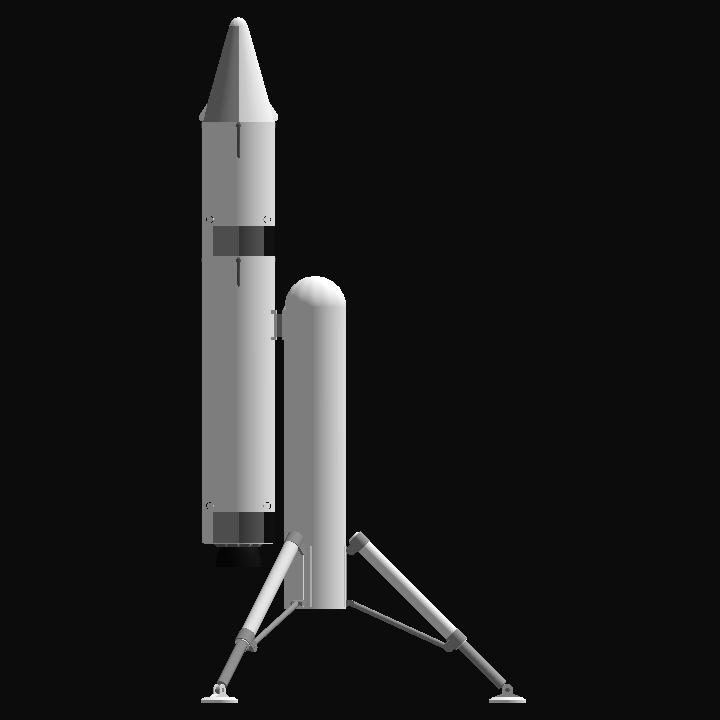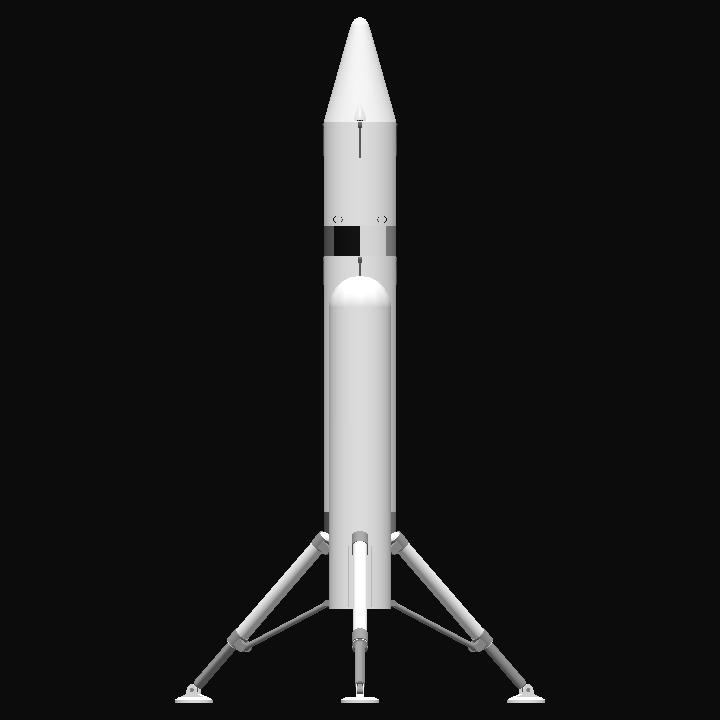CAN HIT EVERYWHERE NOW!
Instructions:
1. After loading the craft into the sandbox, switch to map view and select a craft or a structure then target it. Recommended minimum distance to target from launch site is 900km.
2. After selecting a target craft or structure, switch back to craft view and enable AG1. Three dialogs will appear and each one will be explained by the following:
• Initial Angle - set to 55 for shallower trajectory and or 60 for steeper trajectory. Recommended initial angle is 57.5 for most ranges.
• Lead - currently the only limiting factor of the missile from achieving perfect accuracy since a lead is needed to account for aerodynamic drag during re-entry. Based on testing, a lead of 7 is recommended if the target is on the opposite side of the planet from the launch site and 1.8 for targets at 1000km away. The only way for accurate hits is if you try a estimated lead first based on how far the target is from launch site then trying again with an adjusted lead based on the previous launch. I am hoping to find a solution to this problem in the future so the program can be almost error free.
• Detonation Mode - Air Burst detonates the warhead below 1.5km and Ground Burst detonates near the ground.
3. After the dialogs, AG1 will be automatically disabled and once you are ready to launch, enable AG1 again and let the missile fly itself towards the target. Only touch what is instructed here as the vizzy program could fail if interrupted by user inputs.
4. In some time midway through the flight, when the Distance to Target is close enough, the warhead bus will start maneuvering towards the flight path that will take the warhead to its target so I ask please to not touch anything in this period as it may affect the accuracy of the missile. You can resume operating the craft once AG9 is turned off after the maneuvers.
5. After AG9 has been disabled, you can then enable the AG(Release Warhead) for releasing a single warhead at a time or AG (Release All) for releasing all the warheads at once. From an upright position relative to the horizon, 0 is the topmost warhead and 1 to 5 clockwise from 0 and 6 is the center warhead. After releasing the desired warhead, you may spectate it by enabling AG(Spectate Warhead) to view its descent back to Droo and confirm the accuracy of the missile. The warhead will always try to point prograde so you can't execute other manuevers. Once the warhead reaches the point where the detonation mode is active, the game runs in slow-motion for a massive explosion.
Demo: https://youtu.be/02Y7GOn-hgA?si=QwjE_CWaZ8ddAvYM
Credit and thanks to GoldenShadow's Impact Prediction Code that made this possible in the first place. Without him I would've probably not come up with anything at all about the guidance of this missile.
GENERAL INFO
- Predecessor: StaggerStar
- Created On: Android
- Game Version: 1.3.204.1
- Price: $15,047,806k
- Number of Parts: 215
- Dimensions: 22 m x 11 m x 10 m
PERFORMANCE
- Total Delta V: 6.0km/s
- Total Thrust: 1.8MN
- Engines: 31
- Wet Mass: 4.23E+5kg
- Dry Mass: 3.93E+5kg
STAGES
| Stage | Engines | Delta V | Thrust | Burn | Mass |
|---|---|---|---|---|---|
| 2 | 6 | 2.7km/s | 1.2MN | 60s | 37,637kg |
| 3 | 6 | 2.6km/s | 311kN | 80s | 13,094kg |
| 4 | 6 | 669m/s | 6kN | 6.6m | 3,584kg |
21 Comments
- Log in to leave a comment
-
6,017 OverCAT83+1 10 months ago
@HEMGroup And in the 2nd stage flight, notice how I can detach the bus from it even tho the motor is clearly not depleted yet? That's because to prevent the 2nd stage to overshoot the impact zone away from the target, I have a motor inside the tank which is identical to the motor propelling the second stage but facing the opposite way therefore stopping the acceleration of the 2nd stage and allows the bus to safely separate.
-
6,017 OverCAT83+1 10 months ago
@HEMGroup The problem with the TVC is the motor is attached to a small disc of a fuel tank so if I made it work like that, the burn time would be below a second and that's the reason it can't draw fuel from the actual fuel tank containing the solid propellant. So Each of those engine has been tweaked so that they burn for 60s for the first stage and 80s for the 2nd stage to make it work like a normal rocket would.
-
600 HEMGroup+1 10 months ago
@OverCAT83 That's true,
this could be one of the reasons.
But the new missile I'm developing has an impact speed of about Mach 9, and even so, if it doesn't maneuver inside the atmosphere, Trition's SAF could destroy it (although, this is assuming the missile is at least 60 kilometers away at launch). -
600 HEMGroup+1 10 months ago
@OverCAT83 Oh,
I didn’t see this type of TVC in your missile and thought you were controlling it with a gyro.
You’ve really done an impressive job!
I wanted to do this using fins installed outside the engine and in front of it (so that the exhaust gases would hit those surfaces and change the thrust vector), but it didn’t work.
That was truly a clever move!
Just one question:
What’s the purpose of that second engine you placed facing upwards (both in the first and second stages)? -
6,017 OverCAT8310 months ago
@EhsanA if I made a RSS icbm it would probably be harder to intercept at re-entry I guess
-
600 HEMGroup10 months ago
@TritonAerospace Of course, some missiles also correct their trajectory outside the atmosphere using a small engine they have.
-
6,017 OverCAT8310 months ago
@EhsanA A better reason why you could hit me tho is the distances covered in juno are tiny compared to irl earth which if earth has greater distances, it could also mean the warheads are traveling way faster than what you can achieve in juno therefore easier to track.
-
600 HEMGroup+1 10 months ago
@OverCAT83 @OverCAT83 Yeah, that's right.
Usually, MIRVs don't have control surfaces, and in the real world, due to their extremely high speed, intercepting them is practically impossible. But in Juno, since I can track your position even from 1000 km away, I can hit you, which reduces Juno's realism a bit. -
6,017 OverCAT83+1 10 months ago
@TritonAerospace I yearned for a tvc solid motor in the game until I found a guy in the crafts section that built one using rotators and pistons as actuators and then finally I was able to make a more authentic ICBM. The integrated thrusters are cool but I thought if this was IRL that it's IR sig could be increased greatly by using those to control the missile so I only use them for roll instead of all axes. Thanks for you too since when I was at Golden's post I saw your comment about making one and that's where it began.
-
12.2k TritonAerospace+1 10 months ago
you are guiding it all the way as well.
genius way of integrating roll and pitch thrusters in the missile body. -
-
6,017 OverCAT8310 months ago
@EhsanA No I have not tested it against ABMs yet. Maybe I'll do that once I have solved the lead issue. I think most MIRV don't have a control surface but rather they just stabilize themselves by inducing a spin to them after release. In my case here I have a gyro on the back of the warhead that keeps it pointing prograde for the least drag loss during re-entry.
-
6,017 OverCAT8310 months ago
@EhsanA I thought it was just the planets rotation that caused that but if the rotation velocity is already induced before launching and as long as you don't alter the horizontal velocity it should theoretically land back at the same place but what you said is true so the effect is there. Maybe GoldenShadow's code accounts for that too already but I don't understand it well enough all I know is it accounts for rotation but it could also have it.
-
600 HEMGroup+1 10 months ago
@OverCAT83 Yes, it exists.
If you launch a rocket straight up, completely vertical, and it reaches an apogee of, say, 1000 kilometers, you’ll notice that it doesn’t come back to the same spot it was launched from. That’s due to the Coriolis effect. -
600 HEMGroup+1 10 months ago
@OverCAT83 You’ve done really creative work—congratulations!
So, you’re only performing corrections in the Midcourse phase, and yet you’re achieving remarkable accuracy, considering that warheads lack aerodynamic surfaces for correction within the atmosphere.Have you tested its effectiveness against anti-ballistic missile systems?
-
-
6,017 OverCAT8310 months ago
@EhsanA In boost phase, it only is heading at the target with no correction at all. Once the target is <1800km away, the maneuver starts which is using GoldenShadow's impact prediction code as a point to align with the target position by creating a vector towards them and projecting that vector towards my plane which results to a very accurate alignment because GoldenShadow's code accounts for rotation of the planet, there's four stages to the maneuver: 1st, is it just makes a broad adjustment to the distance of impact point to the target position. 2nd, once the distance between is below 30km, it switches to vector that is not in plane with the bus but to the to the vector pointing from the impact position to the target position which results in even higher accuracy that is needed. 3rd, once distance is at 5000m, the bus starts to rapidly throttle down as at these ranges it becomes very sensitive to large velocity changes until it reaches 550m, then I switch to using RCS to further decrease the distance to 30m. 4th, after reaching 30m, it locks heading directly to the target and exexutes a lead burn which is the final touch to making the warhead actually hit but as I said in the post, its still quite a problem I'm solving so when that gets ironed out, you should be able to get a approximate CEP for this but for now its up to the input lead which is a guess everytime and not ideal at all.
-
600 HEMGroup+1 10 months ago
Can I ask what the purpose of the warhead bus maneuver is?
Is it because the Earth's Coriolis acceleration wasn't accounted for during the boost phase? -
6,017 OverCAT83+2 10 months ago
@IcEStaR Thanks for that, I should've put a spin on them way before I started on the vizzy itself but I got lazy so time to do that now. For the trajectory, making it too steep doesn't really make it feel good to me like the path it takes just feels more awkward but maybe that's because Droo is smaller than earth and I prefer using depressed trajectories to delay detection time greatly but it comes at the cost of drag which I am willing to find a solution for. The range between across the planet for a lead adjustment is around 1-7km and there's should be a math for that. Thanks for the feedback I'll definitely try the spin.
-
4,943 IcEStaR+2 10 months ago
To improve the accuracy of warheads you can twist them around their axis to create a gyroscopic effect.
Also I think to minimize the effect of atmosphere on warhead accuracy (and to counteract missile defense systems xD) you can increase the apogee (make the trajectory of the warhead very steep), in this case the warhead will have more speed and kinetic energy. I think this should help..
Looking forward to the next modification :)





There may still be some problems with it so please let me know if you encounter one. Thank you.